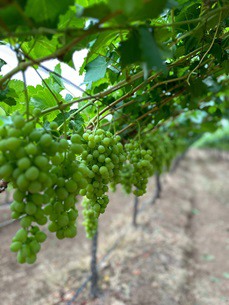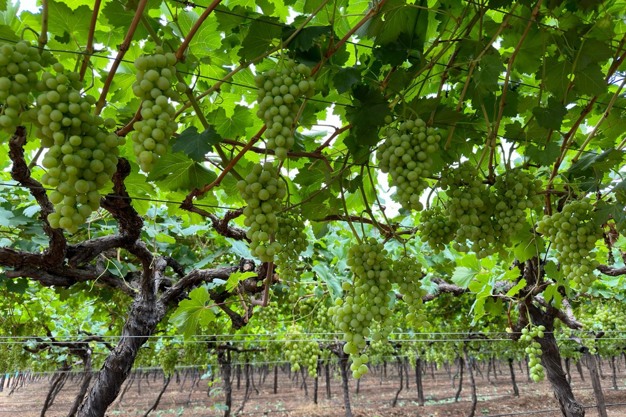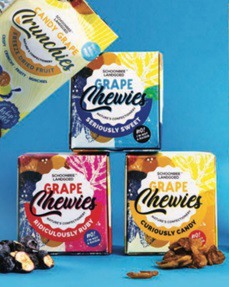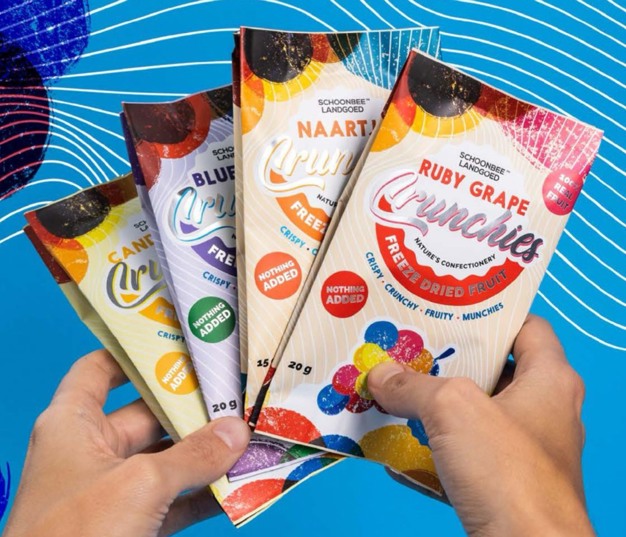 Limpopo's first summer rains have washed the dust off the table grape vines of Loskop Valley, boosting their growth, but their table grape season is expected to commence around ten days later. It is the second smallest of the five South African production areas, but the very first.
Limpopo's first summer rains have washed the dust off the table grape vines of Loskop Valley, boosting their growth, but their table grape season is expected to commence around ten days later. It is the second smallest of the five South African production areas, but the very first.
Right: Schoonbee's Early Sweet white seedless harvest will start at the end of week 45
Every year it's a tight race with Namibian grape growers and the changeover to the Southern Hemisphere will come quickly this year, says Gert Upton of Schoonbee Landgoed where he is marketing manager, emerging from a citrus season he regards as a mixed bag with lower production volumes, long supply of Egyptian oranges and Chinese and Spanish lemons and characterized by slow market reactions until the very end.
The extreme July frost that left swathes of lower-lying citrus trees frozen throughout the Loskop Valley and beyond, had a less severe effect on grape vines.
The first crop estimate of 76.4 million 4.5kg cartons, a one percent increase on the previous season, was issued by the South African Table Grape Industry at the start of the month. "I think further amendments will follow," he says. "I recently spoke to an exporter of Orange River grapes who told me they immediately subtracted a further 10% from the initial estimate for their region."
Peru is a big competitor during South Africa's early grape season but their harvest is three to four weeks later; last week's figures show its reduction in shipping to Europe was in the single digits, but to the USA Peru had sent 87% less grapes as America works through its own production.
The Red Sea problem is going nowhere, Upton says, and grape producers will be very cautious, especially Indian growers who were hurt badly last year by a sharp rise in costs, the obligation to sail around the Cape of Good Hope which has already caused an oil spill and containers overboard during the winter storms. They will be thinking twice before sending too much to Europe, preferring to first explore options closer to home.
The reduction in Lebanese and Israeli grapes in the Mediterranean and Middle East region will create opportunities for South Africa and India.

In two weeks these Early Sweet grapes will be ready for harvest
Early grapes subsidise the late ones
Domestically retailers will stop importing Spanish grapes sooner. The quality hadn't been great this year Upton says because of extreme heat and precipitation over southern Europe; a retail grape buyer agrees with his assessment, adding that Egyptian grapes, on the other hand, had had a good season in South Africa.
Imported grape punnets sell for between R55 (2.9 euros) and R75 (4 euros), an exorbitant price from most South Africans' viewpoint, but he understands why that is, he says, with the costs of getting it here and then the waste factor.
"White grapes are going to dry up quickly, red will continue a bit longer, and the market will swing over to South African product quicker."
Traditionally, three weeks after the Southern African grape season opens, the prices attain the sweet spot band when supply and demand easily meet each other and grape growers make enough to re-invest into farms and packhouses, not just surviving. But after Christmas, around weeks one and two, the grape price drops "and then we're losing money all the way".
Their early grapes subsidise the later grapes, he frankly states, and it's not unique to them. Last year the season started off well but all fruit packed after week 51 experienced a lot of pressure overseas.

The red grape harvest will start in week 46
"The local market has to be an option."
"Our problem is the changeability of our weather, a problem shared with the Western Cape: if they can't load anything in week 4 because the wind is blowing nonstop, then the local or closer markets away from Cape Town Port has to be an option."
And local retailers ought to support the South African grape industry, not stick to Namibian grapes for longer than they need to, he insists. Support for South African producers and produce in season should come first, but some retailers continue importing grapes from Namibia, he says, when even the Hex River Valley in the Western Cape is harvesting their grapes.
New products from potential food waste The food waste generated over the past few years by a knotty logistics chain and new sustainability obligations, such as reduced sailing speeds, has left Schoonbee Landgoed with a significant amount of fruit without a future.
The food waste generated over the past few years by a knotty logistics chain and new sustainability obligations, such as reduced sailing speeds, has left Schoonbee Landgoed with a significant amount of fruit without a future.
Right: The Grape Chewies range are made by dehydrating Sable Seedless®, Crimson and Cotton Candy™
To a destination like Malaysia, he says, packing, port and shipping time has increased from around eighteen days to as long as 35 days. "My product has a shelf life from packing of 45 days – now add an extra ten days to the voyage and you can see how astounding amounts of food waste happen. I farmed the product in the same way, it just took longer to get there, and now I have to work over 20% and throw away 10%."
Instead of waiting for the claims, therefore, Schoonbee threw in much effort to re-imagine the future for discarded fruit, working with their inhouse product developer Cornelia van Zyl and team. They've been selling their citrus crisps and fruit chewies through their online shop, alongside an expanded offering to reflect the broader agricultural production in the Loskop Valley. Online culinary store Yuppiechef now also carries the Schoonbee product line.
The grape chewies, for instance, are emphatically not raisins, he says, and made in a whole different way: berries are cut in slices thick enough to remain moist and placed in a dehydrator. The sterile process obviates the need for preserving the fruit with sulphur dioxide.
 Freeze-dried fruit reduce the food waste percentage
Freeze-dried fruit reduce the food waste percentage
For more information: Gert Upton
Gert Upton
Schoonbee Landgoed
Tel: +2713 262 4000
Email: [email protected]
schoonbee.co.za
